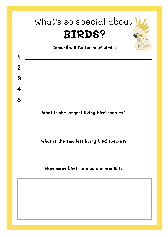Bird Beaks and Bird Feet Adaptations, Science Game
This game will help children learn about the functions of the different beaks and feet of a bird. Birds look very different. The most obvious difference relates to their feet and beaks, which are adapted for specialized functions.
A bird’s beak and feet tell the story of its habitat and lifestyle, and its adaptations to its environment. Most birds are classified based on the structural similarities between their beaks and feet. For example, some fish-eating birds have rough edges on their beaks to grip their catch. Others like the hummingbird, have long needle-like beaks that make it easy to drink nectar from flowers.
The feet of birds are important for navigating the environment. Long claws, or talons from birds such as the bald head eagle, are used to catch and break prey. Similarly, different species have different foot shapes to fit their habitats. Wood ducks, mallard ducks, and sparrows all have specialized feet and beaks. The webbed feet of a duck helps it to move easily in water and swampy areas.
The shape and size of a bird’s beak and feet can provide clues about what the bird eats. Although most birds catch their food using their beak, their beaks are highly specialized. For instance, the beak of a sword-billed hummingbird is longer than the rest of its body.
Birds’ beaks tell us a lot about their habits and lifestyle. For example, a duck’s beak is flat with two nostrils designed to filter mud and trap food in water.
Another interesting aspect of bird anatomy is their feathers. The feathers on owls for instance, are particularly large and dense, allowing them to fly silently in the air. If you’re ever in the presence of a woodpecker be sure to take note of their beaks and how they are designed to hammer at barks of trees.
The feet of birds are important for navigating the environment. Long claws, or talons from birds such as the bald head eagle, are used to catch and break prey. Similarly, different species have different foot shapes to fit their habitats. Wood ducks, mallard ducks, and sparrows all have specialized feet and beaks. The webbed feet of a duck helps it to move easily in water and swampy areas.
The shape and size of a bird’s beak and feet can provide clues about what the bird eats. Although most birds catch their food using their beak, their beaks are highly specialized. For instance, the beak of a sword-billed hummingbird is longer than the rest of its body.
Birds’ beaks tell us a lot about their habits and lifestyle. For example, a duck’s beak is flat with two nostrils designed to filter mud and trap food in water.
Another interesting aspect of bird anatomy is their feathers. The feathers on owls for instance, are particularly large and dense, allowing them to fly silently in the air. If you’re ever in the presence of a woodpecker be sure to take note of their beaks and how they are designed to hammer at barks of trees.









